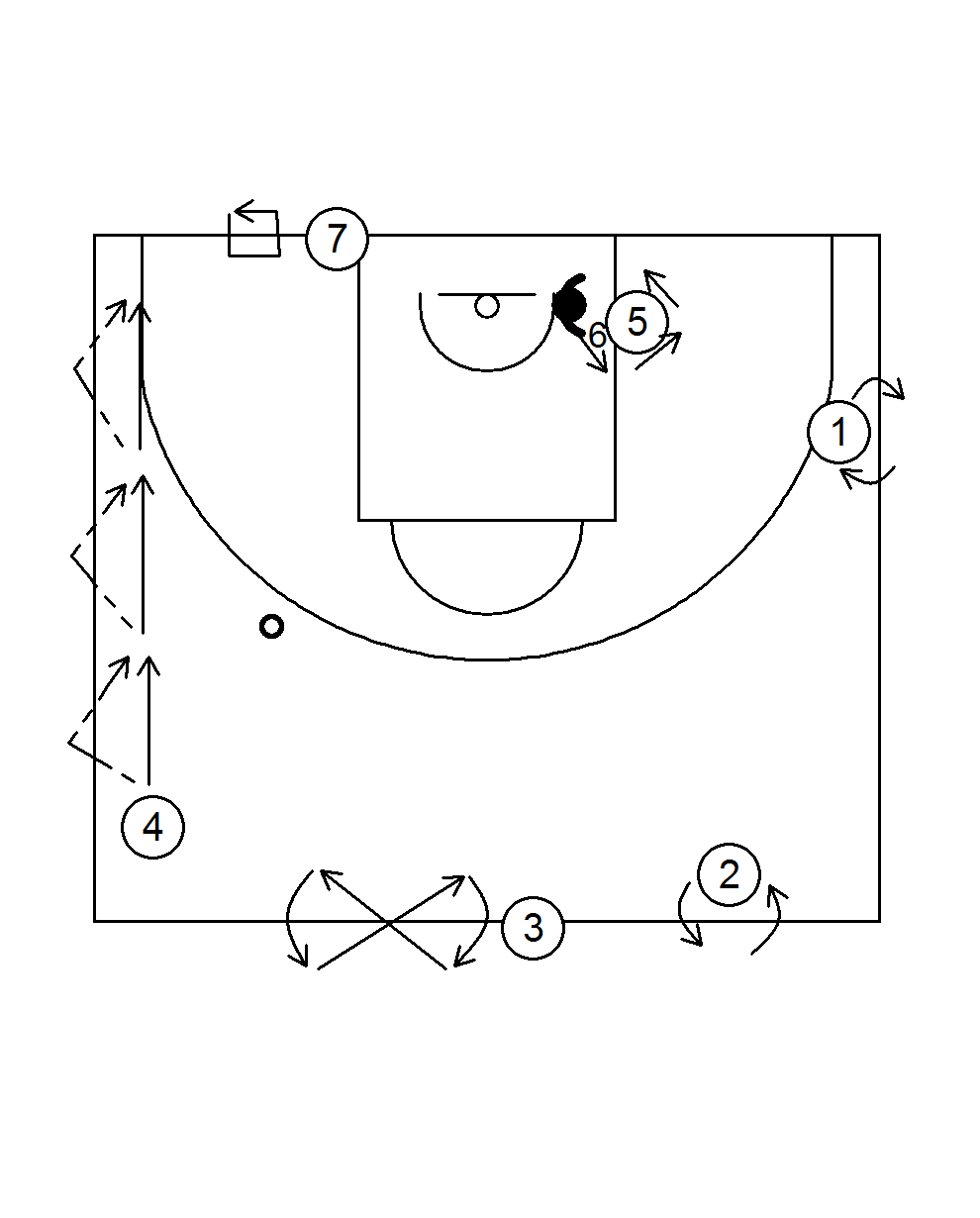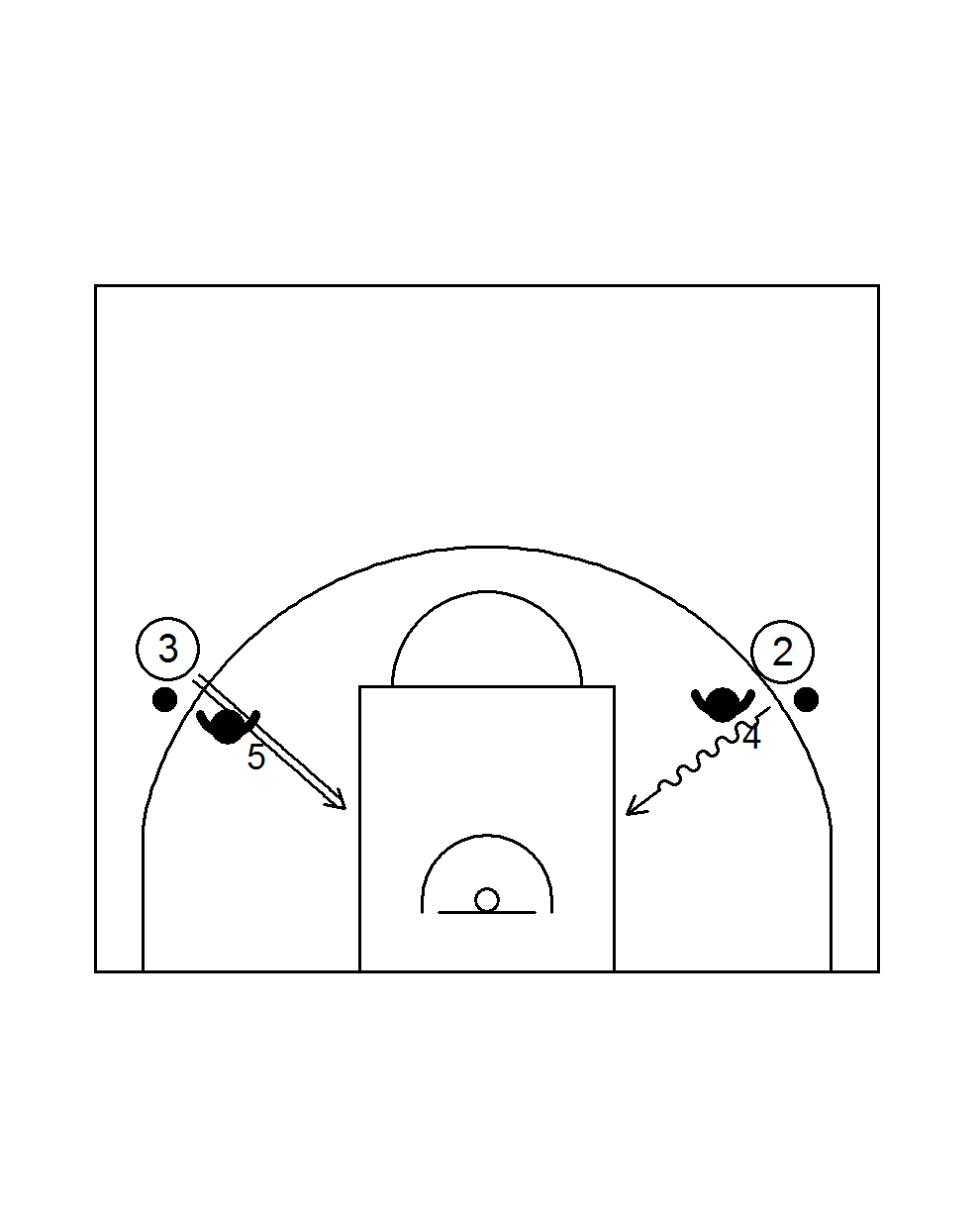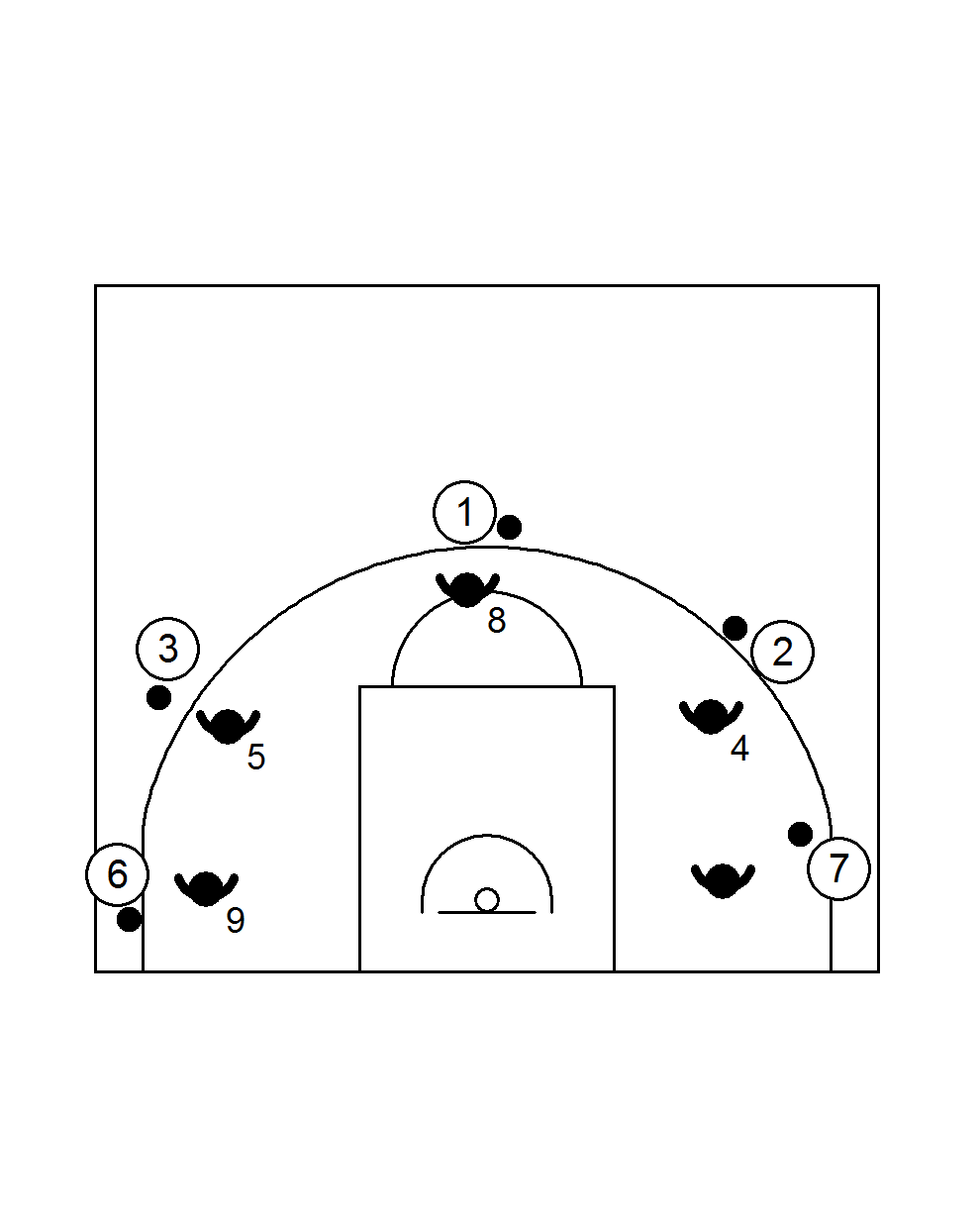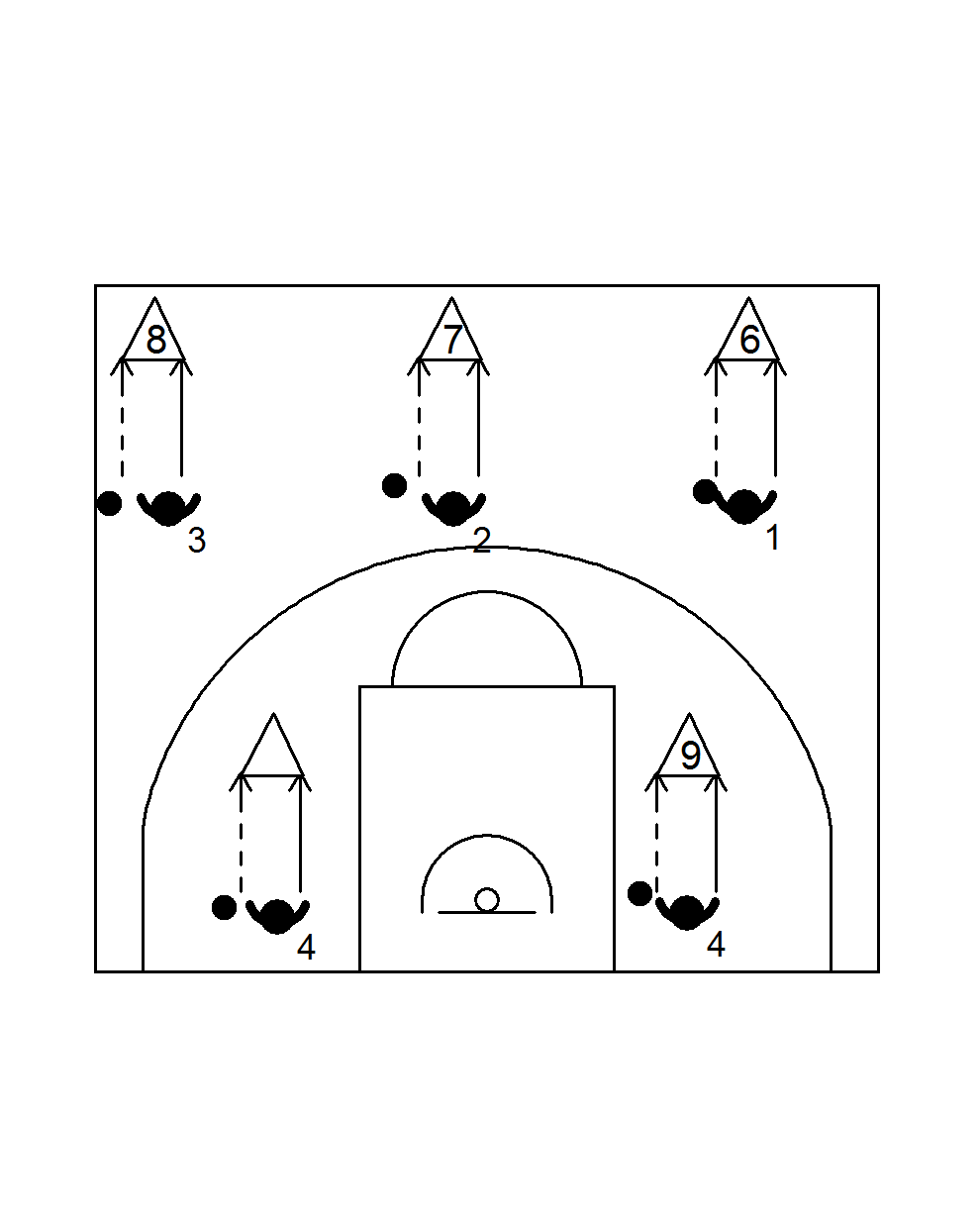Basketball drills
Requirements:
players must be able to drive and shoot from the 3-point line
Goal: forwards
learn to get free by reading the defense
Organization:
Defender is instructed by the trainer how to react when the attacker cuts inside for the first time:
- stay put
- pass
- stick to the attacker
- passer static on the guard position
- passes to the attacker when he gets free
- who then plays 1 against 1
- loser defends on the same side
- winner takes the ball and attacks on the other side
- play until the 4
Teaching points:
- defender stays put: step outside the three-point line for the shot
- Defender overshoots (you can't see the ball well because the defender is in between): go back through (explosive, hard offload on your outside leg)
- defender sticks: pin and spin (after the spin make your line form the letter V, so the defender stays behind you and cannot intercept the pass)
- if the attacker is still not free after 2 times, then the defender has won
Endgame:
Let the defender vary the way he/she defends so that the attacker really has to read and react appropriately.
The trainer instructs the defender to successively:
- follow
- pass
- stick
- Attacker starts against the back line
- moves parallel to the bucket towards the ball
- if the defender follows, accelerate at the elbow by pushing off hard on the inside foot and step out perpendicular to your line of play
- if the defender sticks, then perform a pin and spin on the elbow and step out hard perpendicularly
- if the defender sticks at the elbow: ask for the pass at the three-point line and shoot
- if you cannot see more than the defender's hand between you and the ball, call for the pass with your outside hand at the three-point line
- after catching the ball, rip it and drive directly to the basket
- if you see the defender's shoulders between yourself and the ball, then drop off hard on your outside foot and go back through (ask for bounce pass on your outside hand)
Endgame:
Defender varies the way you defend, so the attacker really has to read and react appropriately
Mtm offense
- Coach instructs defender to consecutively:
- keep position between attacker and basket
- Pass from the extended free throw line.
- Attacker runs outside along the three-point line:
- If the defender stays between man and basket, call for the pass with your outside hand at the three-point line.
- Take your triple threat position and play 1 against 1.
- if you can see the defender's shoulder when looking at the ball, then push hard on your off-side foot and go back through (ask for bounce pass on your off-side hand)
- Same if the defender puts a foot over the three point line
Endgame:
Defender varies the way you defend so the attacker really has to read and react appropriately
Requirements:
players must be able to drive and shoot from the 3-point line
Goal: get free
at the forward position and improve scoring ability from that position
Organization:
- coach dribbles at guard position
- occasionally threatens to penetrate and defender 5 must step in. He always has to defend the ball as well!
- Forward makes sure he gets free with an in-out move, backdoor or pick-up + flash
- gets free
- then plays 1 against 1
- Loser goes to defend
- catch it yourself, dribble to the other side than where you started.
- play until the 3
Teaching points:
- face the basket immediately after receiving the ball
- use the front or reverse pivot immediately as a feint
- Sit deep in the spin
- high speed
- maximum 1 dribble to the basket
- If the defender gives space, shoot immediately
Requirements:
players must be able to run a lay up from a bounce pass
Goal: To learn
how to create scoring opportunities for yourself as a forward
Organization:
The helpline is out: this allows you to play with two foursomes on one basket and forces players to not use the space where in the game the help is.
- Make it, take it and play to the 5.
- guard dribbles up from the center circle
- at the same time 2 makes a V-cut
- if defender 4 overplays, then extend the V-cut to at least one meter
- above the three-point line and sprint backwards for the backdoor pass.
- if the back pass is not possible because defender 4 stays between the ball and 2
- then 1 dribbles to the wing
- and posts 2 at the block
- gets the ball via a bouce pass from the wing
- and plays 1 against 1
- when defender 4 doesn't pass, 1 passes to 2
- 2 makes one feint and goes hard to the basket
All score from:
- back by
- 1 against 1 from the wing
- 1 against 1 from the block
Mtm offense
If 2 fails to pass, 2 sprints to the center circle and receives the pass from 1. The cycle then starts all over again, but now with 1 at the forward position.
Teaching Points:
- if you can see your defender's shoulder in the passing line at the V-cut, it is a replay
- and you have to take the defender at least one meter above the three-point line towards the sideline.
- print at full speed when your back passes
- the back through pass is mostly one-handed, from the dribble with a flat bounce
- when posting up, first take the defender into the bucket, turn 180 degrees (pin & spin) and land with a hop on the block (both feet outside the bucket line)
Prerequisites:
no specific requirements
Goal: To learn
to use the front cut from the forward position when the defender closes the back door cut.
Organization:
- the dribbler dribbles from the centre circle towards the ball side
- changes direction with an under the buttocks or between the legs towards the guard position on the half way line
- forward pretends to go back, but cuts over the elbow to the basket
- guard players are constantly working on their dribbling skills
Teaching points:
- hard off the outside foot
- cut around the ball box shoulder to shoulder
- Show with your hands where you want to receive the ball
- timing of the pass: should be somewhere near the elbow and in front of the man
Variations:
- different ways of finishing: jump shot, rocker step, fade away, power move etc
- Have the dribbler apply different dribbling skills
- Different passes: bounce from the dribble, overhead etc.
Objective:
A) feint your dribbleB
) drive to the basket
Organization:
- flow form (pass and chase your ball, take over your predecessor's position)
- the drive to the basket starts at the half way line, against the sideline.
- dribble start
- Feint your dribble
- accelerate
- In line with the free throw line cross the three point line and lay up.
- pass-stations at the guard position and the opposite forward position.
- If necessary, use pawns to determine your position.
- always fake a pass from the ball intake in the opposite direction of the pass. Move the foot and the ball quickly and briefly (on the diagram, the left foot). Then place the foot in front of the ball, release the pivot foot, pass and continue immediately.
- Ball is below knee height, knees bent at 90 degrees.
- Crossover step and with 1 bounce + lay up to the basket.
- catch the ball yourself, put one foot in the direction of the outlet, release the pivot foot, pass and continue directly.
TIP:
Put pawns down as defenders to force change of direction
Teaching Points:
- adjust on the outside hand
- Knees slightly bent on receiving pass
- Protect the ball next to the body
- At every dribble start, the ball and foot should hit the ground at the same time.
- Feints on the pass must be short and fierce.
- move the foot and ball during feints
- after the feint, accelerate on the dribble and finish at top speed
Variations:
- backup dribble (start with the right and continue)
- Tapping during the dribble (start on the right and continue)
- crossover (start on the left, continue with the right and finish)
- start on the right, corssover and finish through the middle with the left
- stop + jump shot instead of lay up
- from the left side
Requirements:
players must be able to run a lay up from a bounce pass
Goal: learn
how to punish the overplaying of the forward by an aggressive defense
Organization:
- guard dribbles up from behind the centre circle
- at the same moment the centre 4 comes to the elbow
- and player 3 sprints to the pawn
- 1 passes to 4 with a bounce pass
- 3 sprints to the basket with a sharp change of direction and speed
- and receives the bounce pass from 4
Rotation:
- 4 grabs the rebound
- and takes the ball on the back line
- 3 goes to defend the inbound pass
- when 9 receives the ball, 7 takes position at the sideline for the next inbound pass
- 4 and 5 do not rotate but take turns.
- 1 joins the line behind the pawn
- 9 passes the ball to 8 and joins the row behind it
Variation:
- 1 pretends he is going to put a screen away on the weak side, but cuts to 4 for a hand off
- takes the shot
- OR plays pick and roll with 4
Teaching Points:
- Sprint to the pawn: when passing, you as the attacker must take the defender well outside the three-point line to create enough space for the back door.
- 1 must feint immediately after the pass to be in time for the hand-off.
Requirements:
players must be able to drive and shoot from the 3-point line
Goal: get free
at the forward position and improve scoring ability from that position
Organization:
- attacker 1 receives the pass from 2 after a shallow cut
- and plays 1 against 1 against defender 4
- 2 waits for 2 seconds and runs a shallow cut to the other side of the basket and plays 1 against 1 against 5
- defender counts down aloud as soon as the attacker has the ball in his hands: 23, 22, 21.
- If the ball has not yet touched the ring, the point goes to the defender.
- loser of the 1 against 1 goes to defend
- winner takes the ball and runs outside to the back of the row
- play until the 7 (defender gets a point if he stops the attacker from scoring)
Teaching points:
- first cut to the basket
- then change direction and speed hard to the three-point line
- Ask for the ball on the outside
- face the basket immediately after receiving the ball
- use the front or reverse pivot immediately as a feint
- read in this pivoting movement on which side the defender leaves room (shot, crossover or open step)
- sit deep in the turn
- high speed of action: with a maximum of one feint, unbalance the defender and move to the basket
- Play with full intensity!
Tip:
if the attacker does not read well and always makes only the action he is good at, instruct the defender how to defend it. In this way, the attacker is forced to first look at where the space is and only then make his decision
Requirements:
players must be able to drive and shoot from the 3-point line
Goal:
practice different techniques to score from the forward position
Organization:
- Attacker 3 sprints after the pass directly to the forward position.
- gets the ball there
- and attacks the basket with a high speed of action.
- Starts to land in 2TR and shoots.
- while finishing underneath the basket, always picks up the ball
- with a big approach step to the desired position under the hoop
- Pull on the other foot
- and take off with two feet
Rotation:
- the passer takes a step backwards to make room for the next passer.
- the archer catches the ball and passes it to the passer
- who joins the back of the row with the ball
- the shooter takes the position of the passer.
Catch and go:
- catch the ball and attack directly at the elbow
- sharp change of direction
- high speed
Mtm offense
Jump back:
- Attack the elbow
- Offset under the elbow on your front foot and jump backward
- pick up the ball and shoot
Jump back and drive:
- Attack the elbow
- Jump back and drive: attack the elbow, push off under the elbow onto your front foot and jump backwards
- do not pick up the ball, but change hands and attack the basket at the weak side
1 on 1
- the passer is now slightly deeper
- As soon as he has passed to the forward, he starts defending
- the attacker applies the different techniques he practised before
Rotation:
the pair that has finished the 1v1 move together to the centre line and swap roles OR the loser defends.
Variations:
- left and right
- place the passer in the corner or on the block
- different techniques of finishing under the board
- adding a help defender to the weak side, so that the attacker also learns what (im)possibilities are there.
Requirements:
players must be able to dribble a layup run
Objective:
to increase attacking ability in 1 against 1
Organization:
- player 1 receives the ball from 3
- 3 moves backwards
- 1 unbalances 3, passes and goes hard to the basket
- the defender's task is to stop the dribble
- loser continues to defend on the same side
- winner attacks on the other side
Teaching Points:
- attacker must aggressively close the distance
- dribble straight at the defender
- throw the defender off balance
- attacker must be unpredictable
- choose which side to pass on at the last moment
- Use feints in the dribble
- After passing, go full speed towards the basket
- play with guts
- If you cannot, regain your balance and try another technique, e.g. backup dribble + jump shot.

Requirements:
players must know what the correct defensive posture is have
Goal:
- reinforce good habits regarding defensive position
- To increase speed and flexibility of footwork
Organisation:
- do as circuit, 1 minute each time
- player 1 jumps sideways with 2 feet left and right of the line
- player 2 does that forwards and backwards.
- players jump with 2 feet forward wide - narrow - wide. With a jump in the air they do a 180 degree jump and start over again.
- player 4 passes the ball through the wall to himself and goes with slides to the position where he catches it again. Makes it more and more difficult for himself by increasing the distance.
- player 5 defends the mid post and chooses every time another position (behind, swim over - full front - swim over low and back again)
- player 7 makes a square with jumps on 1 foot (feather by landing) always 2x with right, then 2x with left. First left, then right etc.
Teaching points:
- knees bent
- head above the


Goal: Defending the forward in triple threat position
Organization:
- attacker makes an agreed number of different feints before shooting or dribbling to the basket
- defender must anticipate with a drop step when the attacker threatens to go over the front foot
- with a two-footed backward hop when the attacker threatens to go over the back foot
- when the attacker brings up the ball, the defender should quickly step towards the attacker, stand against him, feet wider than the attacker,
- Trace the ball with your hands
- When the attacker brings the ball back down, the defender returns to his/her original position with a slide step or a hop backwards (arm's length distance)
Teaching points:
- react quickly on the feet, before the attacker does
- Distance from the attacker: match the threat he poses.
- Shorten the distance to the attacker with mini-slides, so that you can react immediately
Variations:
attacker gives a pass to himself from the bucket edge
Starting exercise:
- defender starts at arm's length
- Square up = feet next to each other, chest perpendicular to the line of the ball-basket when the attacker is standing on the axis of the field.
- Left foot forward when the attacker is standing on the right half of the field and vice versa.
- Attacker fakes the shot
- Defender steps forward, hand on ball
- Attacker brings the ball down
- defender recovers arm-length distance
- attacker makes max 2 dribbles, left or right
- after the stop, the defender steps forward again, hand on the ball
Form of play:
- as above, but with shot + boxing out (= wall and rebound)
- 2 scores in a row (also from the rebound!!) OR 2 stops in a row = loser presses and change

Goal: defend the dribbler after stopping the dribble
Organization:
- man with ball passes to opponent when trainer whistles
- who takes 1 bounce and stops the dribble in 2 Count Rhythm (2TR)
- The trainer counts down 5 seconds and then blows his whistle as end signal
- The aggressive defender steps back to his starting position
- The roles are now reversed
- As soon as the trainer whistles you pass the ball to the other player
- go for it aggressively straight away
- Try to prevent the other player from passing by keeping your hand in front of the ball (trace the ball)
- Try to get your feet to the left and right of the pivot foot of the man with the ball so that he cannot turn
Teaching Points:
- avoid mistakes; do not hit the ball
- Go for the 5 seconds
- Get as close as possible to the attacker (but stay in your own cylinder)
- Move your feet closer to the attacker, but keep your position between the attacker and the basket.
Variations:
- a third man to whom the ball must be passed within 5 seconds. Choose a limited area in which the third man can run free (use lines on the court, or place pawns).
- Pass from under the board to the player on the block. This player must try to pivot past the defender and score. Winner becomes attacker on the block, loser passes from the back line.
Form of play:
- Ten ball on the half court, where the receiver of the ball has to make a dribble start with 1 bounce before he can pass the ball on.
- idem, but defence MUST double team the man with the ball.








